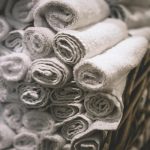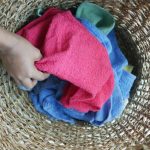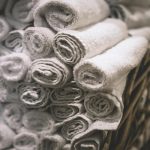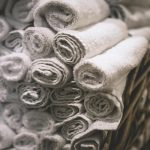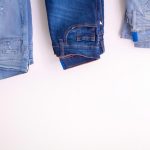When it comes to choosing the right cleaning cloth, you might wonder how waffle terry stacks up against microfiber in terms of efficiency. Waffle terry features a unique texture that helps scrub away tougher stains, while microfiber is known for its dust-trapping capabilities. Both fabrics have their strengths, but which one truly excels in more challenging cleaning scenarios? It's not just about absorbency or scrubbing power; there's more to consider that could influence your cleaning routine. Let's explore these differences further to find out which option can better meet your cleaning needs.
Table of Contents
Overview of Waffle Terry Cloth
Waffle terry cloth, known for its unique textured pattern, provides excellent absorbency and a soft touch that makes it a popular choice for towels and bedding.
The distinctive squares and ridges in the fabric not only enhance its aesthetic appeal but also increase its surface area, allowing it to soak up moisture efficiently.
When you use waffle terry cloth, you'll likely notice its ability to dry quickly, reducing the risk of mildew compared to standard terry cloth.
This fabric's lightweight nature makes it easy to handle, and you'll appreciate how soft it feels against your skin.
It's breathable and comfortable, making it perfect for a variety of uses beyond towels and bedding.
Consider how it works well in spa settings, as bathrobes, or even in table linens, offering a touch of luxury while remaining practical.
Waffle terry cloth is typically made from cotton, which means you get natural fibers that are gentle on the skin.
Its durability ensures that it withstands multiple washes without losing absorbency.
Next time you reach for a towel or a robe, you'll likely find yourself enjoying the benefits of waffle terry cloth.
Overview of Microfiber Fabric
Microfiber fabric consists of ultra-fine synthetic fibers that offer remarkable softness and impressive durability, making it a popular alternative to natural materials like waffle terry cloth. You'll find microfiber's tiny fibers, usually measuring less than one denier, can easily trap dirt, dust, and allergens, making it an effective cleaning option. Its lightweight and compact nature also makes it convenient for storage and portability.
Here's a comparison of microfiber's key features:
| Feature | Microfiber |
|---|---|
| Fiber composition | Synthetic (polyester, nylon) |
| Softness | Extremely soft |
| Durability | High durability |
| Cleaning efficiency | Excellent |
Moreover, microfiber dries quickly and resists mold and mildew growth, enhancing its utility in various cleaning tasks. You'll love how it can be used on multiple surfaces without scratching or leaving streaks. Understanding these properties can help you make informed decisions when choosing between microfiber and waffle terry fabrics for cleaning purposes. Both offer unique advantages, but microfiber certainly shines when it comes to efficiency and versatility.
Absorbency Comparison
When it comes to absorbency, waffle terry generally outperforms microfiber due to its unique looped structure designed to hold more moisture. This design not only enables waffle terry to soak up spills and liquids quickly but also prevents them from spreading, making the cleaning process more efficient. You'll find that when you're wiping surfaces, waffle terry grabs and retains moisture better than microfiber, which can sometimes leave behind a damp residue.
Microfiber, while absorbent, typically spreads moisture over surfaces rather than absorbing it into its fibers. This can be less effective when tackling larger spills or messes, as it may require multiple passes to soak up what's needed. If you're looking for a towel or cloth that can handle heavy-duty cleaning tasks, waffle terry is likely your best bet.
Additionally, the greater surface area of waffle terry means it can maintain its absorbency over longer periods. You won't need to reach for multiple cloths during a single cleaning session, making your efforts more streamlined. Whether you're dealing with kitchen spills, bathroom messes, or dust, choosing waffle terry will enhance your cleaning efficiency significantly.
Durability Analysis
Durability is a crucial factor to consider, as both waffle terry and microfiber have distinct strengths that can impact their longevity in various cleaning tasks.
Waffle terry, made from cotton, tends to be quite durable due to its robust weave. It can withstand multiple washes without losing its integrity, making it a practical choice for heavy-duty cleaning. However, it can wear down over time, especially if subjected to harsh detergents or high heat.
On the other hand, microfiber is engineered for durability, often lasting longer than traditional fabrics. Its synthetic fibers resist fraying and can be washed extensively without significant wear. Microfiber is also less likely to develop stains or retain odors, which can contribute to its longevity in cleaning routines.
When evaluating durability, consider your cleaning frequency and the conditions of use. If you're tackling tough jobs regularly, waffle terry may serve you well, but for lighter, more frequent tasks, microfiber might be the better option. Both fabrics have their place, so think about what suits your specific cleaning needs to maximize longevity.
Overall Cleaning Performance
Overall cleaning performance varies significantly between waffle terry and microfiber, as each fabric has unique properties that affect how effectively they tackle dirt and grime.
Waffle terry's textured surface is great for scrubbing, allowing it to lift away embedded dirt. This fabric works well on tougher messes, making it suitable for kitchen and bathroom cleaning. However, it might leave some streaks on glass and shiny surfaces.
Microfiber, on the other hand, excels at trapping and absorbing dust and moisture. Its fine fibers create a large surface area, making it highly effective for light cleaning tasks. When you're dusting or wiping down surfaces, microfiber's ability to trap particles helps ensure you don't just push around dirt.
When you need deep cleaning, waffle terry might serve you better. For daily cleaning and dusting, microfiber shines.
Ultimately, your choice depends on the task at hand. If you're dealing with heavy stains, waffle terry will likely perform better. However, for quick clean-ups and dusting, microfiber's ability to capture finer particles makes it the go-to option.
Understanding these differences can help you select the right fabric for your cleaning needs.
Frequently Asked Questions
Can Waffle Terry Cloth Be Used for Drying Dishes?
Yes, you can use waffle terry cloth for drying dishes. Its absorbent texture effectively soaks up moisture, making it a practical choice for quickly drying dishes while also preventing streaks on glassware and utensils.
Is Microfiber Safe for All Surfaces?
You'll find microfiber's generally safe for most surfaces, but it's best to test it on delicate finishes first. Avoid using it on rough surfaces, as it might cause scratches or damage over time.
How Do You Care for Waffle Terry Cloth?
To care for waffle terry cloth, you should wash it separately in cold water with mild detergent. Avoid using bleach or fabric softeners, and tumble dry on low to keep it soft and durable.
Do Waffle Terry Cloths Leave Lint Behind?
Waffle terry cloths typically don't leave lint behind, thanks to their unique weave. However, ensure you wash them properly and avoid fabric softeners, which can cause lint issues and reduce their effectiveness over time.
Can Microfiber Attract Dust Better Than Waffle Terry Cloth?
Microfiber's unique structure helps it attract and hold dust better than waffle terrycloth. When you use microfiber, you'll notice it effectively traps particles, making your cleaning tasks quicker and more efficient without leaving lint behind.
- How Does Ring Spun Cotton Affect Garment Fit and Shape Retention? - August 13, 2024
- What Are the Challenges in Producing Ring Spun Cotton? - August 13, 2024
- Is Ring Spun Cotton Suitable for Plus-Size Clothing? - August 13, 2024


